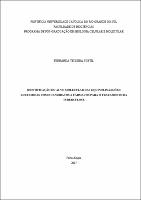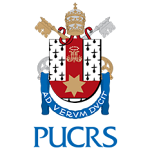| Share record |


|
Please use this identifier to cite or link to this item:
https://tede2.pucrs.br/tede2/handle/tede/7359| Document type: | Dissertação |
| Title: | Identificação do alvo molecular das 2(quinolin-4-ilóxi) acetamidas como candidatos a fármacos para o tratamento da tuberculose |
| Author: | Subtil, Fernanda Teixeira  |
| Advisor: | Santos, Diógenes Santiago |
| First advisor-co: | Villela, Anne Drumond |
| Abstract (native): | A alta incidência da tuberculose, em âmbito mundial, é de grande preocupação. Para combater esta doença, diferentes estratégias vêm sendo desenvolvidas pela Organização Mundial da Saúde (OMS). Dentre os pilares que compõem a End TB strategy, podemos destacar a pesquisa intensiva e a inovação. Neste âmbito, o desenvolvimento de novos fármacos para tuberculose vem ganhando destaque. As 2(quinolin-4-ilóxi) acetamidas são moléculas que demonstraram resultados bactericidas promissores frente ao Mycobacterium tuberculosis, o que nos motivou a realizar novos estudos para melhorar a atividade e realizar a caracterização química e biológica destas moléculas. A fim de continuar o desenvolvimento da série quinolínica, a identificação do seu alvo molecular foi o foco deste trabalho. Inicialmente, levantou-se a hipótese de que a DNA girase seria o alvo molecular, uma vez que as 2(quinolin- 5-ilóxi) acetamidas possuem grande similaridade estrutural com as fluoroquinolonas. Apesar das 2(quinolin-4-ilóxi) acetamidas terem apresentado menor atividade frente a isolados clínicos resistentes a ofloxacino, os resultados de atividade obtidos frente a uma mutante pontual de gyrA e frente à proteína indicam que a DNA girase não é o alvo destas moléculas. A nova estratégia para identificação de alvo envolveu a seleção de mutantes espontâneos para o composto líder 12L, caracterização desta cepa frente aos demais compostos da série e sequencimento total do genoma. Este permitiu a identificação de uma única mutação (T313A) localizada na proteína QcrB, que é a subunidade B do complexo citocromo bc1. Esta mutação foi confirmada por sequenciamento de Sanger e o docking molecular aferiu a importância deste resíduo na interação proteína-composto. O complexo citocromo bc1 está envolvido no transporte de elétrons na cadeia respiratória do bacilo, e por isso é um alvo molecular interessante, principalmente para combater a forma latente da doença. Esperamos que este trabalho contribua no processo de desenvolvimento das 2(quinolin-4-ilóxi) acetamidas para o tratamento da tuberculose. |
| Abstract (english): | The high incidence of tuberculosis is a great concern worldwide. Different strategies are being developed by the World Health Organization to fight tuberculosis. Amongst the three pillars that are part of the End TB Strategy, we can highlight the intensive research and innovation pillar. In this extent, the development of new drugs for tuberculosis treatment is a field that is gaining importance. The 2(quinolin-4-yloxy) acetamides are molecules that showed promising bactericidal effects in Mycobacterium tuberculosis, which motivated us to continue studying to improve their mycobactericidal activity and also perform their chemical and biological characterization. In order to continue the 2(quinolin-4-yloxy) acetamides derivatives development, the target identification of these molecules is a keystone and is also the focus of this study. Initially, it was hypothesized that DNA gyrase was their molecular target due to the great chemical similarities between the 2(quinolin-4-yloxy) acetamides and the fluoroquinolones. Despite our results that the 2(quinolin-4-yloxy) acetamides have diminished effects in ofloxacin resistant clinical isolates, the results obtained with the gyrA point mutant and with DNA gyrase protein revealed that this enzyme is not the molecular target of these compounds. The new target identification strategy involved the selection of spontaneous mutants for our lead compound 12L, characterization of this mutant strain against other 2(quinolin-4-yloxy) acetamides derivates and whole genome sequencing. Whole genome sequencing data allowed the identification of a single mutation (T313A) in the QcrB protein, which is the B subunit of cytochrome bc1 complex. This mutation was confirmed by Sanger sequencing and molecular docking results confirmed the importance of this residue for proteindrug interaction. The cytochrome bc1 complex is involved in the electron transport of the bacilli’s respiratory chain, and therefore it appears to be an interesting target, especially to treat the latent form of the disease. We hope that this work contributes to the 2(quinolin-4-yloxy) acetamides development for tuberculosis treatment. |
| Keywords: | Tuberculose Desenvolvimento de Fármacos Identificação de Alvo |
| CNPQ Knowledge Areas: | CIENCIAS BIOLOGICAS::BIOLOGIA GERAL |
| Language: | por |
| Country: | Brasil |
| Publisher: | Pontifícia Universidade Católica do Rio Grande do Sul |
| Institution Acronym: | PUCRS |
| Department: | Faculdade de Biociências |
| Program: | Programa de Pós-Graduação em Biologia Celular e Molecular |
| Access type: | Acesso Aberto |
| URI: | http://tede2.pucrs.br/tede2/handle/tede/7359 |
| Issue Date: | 3-Mar-2017 |
| Appears in Collections: | Programa de Pós-Graduação em Biologia Celular e Molecular |
Files in This Item:
| File | Description | Size | Format | |
|---|---|---|---|---|
| DIS_FERNANDA_TEIXEIRA_SUBTIL_COMPLETO.pdf | Texto Completo | 1.46 MB | Adobe PDF |  Download/Open Preview |
Items in DSpace are protected by copyright, with all rights reserved, unless otherwise indicated.




